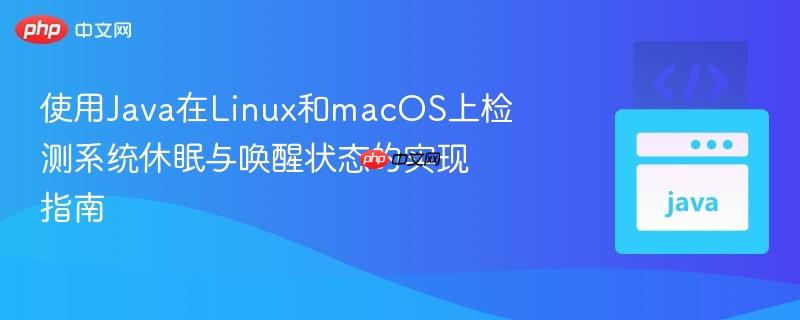
本教程探讨了如何使用java在linux和macos系统上检测工作站的休眠与唤醒事件。首先介绍了理想的java desktop api方法,但指出其在linux系统上的局限性。随后,详细阐述了通过java的processbuilder执行特定操作系统命令(如linux的`upower`和macos的`ioreg`)来获取系统电源状态,并利用java的正则表达式能力进行输出解析,从而实现跨平台、可靠的系统状态监控。
在开发桌面应用程序时,有时需要监听操作系统的工作站休眠(锁屏)或唤醒(解锁)事件,以便在这些状态变化时执行特定逻辑。本文将深入探讨如何使用Java在Linux和macOS环境中实现这一功能。
Java的java.awt.Desktop类提供了一个addAppEventListener方法,理论上可以用于监听系统事件,包括系统休眠和唤醒。这是一种跨平台且无需依赖外部命令的优雅解决方案。
通过实现SystemSleepListener接口,可以捕获systemAboutToSleep和systemAwoke事件。
import java.awt.Desktop;
import java.awt.desktop.SystemSleepEvent;
import java.awt.desktop.SystemSleepListener;
public class SystemSleepDetector {
public static void main(String[] args) {
if (Desktop.isDesktopSupported()) {
Desktop desktop = Desktop.getDesktop();
// 检查当前桌面环境是否支持系统睡眠事件监听
if (desktop.isSupported(Desktop.Action.APP_EVENT_SYSTEM_SLEEP)) {
desktop.addAppEventListener(new SystemSleepListener() {
@Override
public void systemAboutToSleep(SystemSleepEvent event) {
System.out.println("系统即将进入休眠状态。");
// 在系统休眠前执行的逻辑
}
@Override
public void systemAwoke(SystemSleepEvent event) {
System.out.println("系统已从休眠状态唤醒。");
// 在系统唤醒后执行的逻辑
}
});
System.out.println("系统睡眠事件监听器已注册。");
} else {
System.out.println("当前桌面环境不支持系统睡眠事件监听。");
}
} else {
System.out.println("Desktop API 不受支持。");
}
// 保持程序运行以监听事件
try {
Thread.sleep(Long.MAX_VALUE);
} catch (InterruptedException e) {
Thread.currentThread().interrupt();
}
}
}尽管Desktop.addAppEventListener看起来是理想方案,但根据OpenJDK的源代码分析(例如在gtk3_interface.c中),在Linux和Unix系统上,Desktop.Action.APP_EVENT_SYSTEM_SLEEP事件通常是不受支持的。这意味着上述方法在Linux和macOS上可能无法按预期工作,或仅支持有限的桌面环境。因此,对于这些操作系统,需要寻求其他解决方案。
立即学习“Java免费学习笔记(深入)”;
由于Java Desktop API在Linux和macOS上的局限性,通过Java的ProcessBuilder执行原生系统命令成为一种更可靠的替代方案。这种方法利用了操作系统自带的工具来查询电源管理状态。
在Linux系统中,upower工具是一个强大的电源管理接口,可以用来监控电池、电源和系统休眠状态。upower --monitor命令可以实时输出电源事件。
import java.io.BufferedReader;
import java.io.IOException;
import java.io.InputStreamReader;
import java.util.concurrent.CompletableFuture;
public class LinuxSleepDetector {
public static void main(String[] args) {
String os = System.getProperty("os.name");
if (os.contains("Linux")) {
try {
// 构建 upower --monitor 命令
ProcessBuilder builder = new ProcessBuilder("upower", "--monitor");
// 将错误输出重定向到父进程的错误流
builder.redirectError(ProcessBuilder.Redirect.INHERIT);
Process upowerProcess = builder.start();
System.out.println("正在监听Linux系统电源事件...");
// 异步读取命令输出,避免阻塞主线程
CompletableFuture.runAsync(() -> {
try (BufferedReader output = new BufferedReader(new InputStreamReader(upowerProcess.getInputStream()))) {
String line;
while ((line = output.readLine()) != null) {
if (line.contains("sleep") || line.contains("Sleep")) {
System.out.println("系统即将进入休眠状态。");
// 处理系统休眠事件
}
if (line.contains("hibernate") || line.contains("Hibernate")) {
System.out.println("系统正在休眠。");
// 处理系统休眠/休眠事件
}
// upower --monitor 会持续输出,也可能包含唤醒事件
// 根据具体输出内容进行判断,例如“device changed”后电源状态变化
// 实际的唤醒事件可能需要更复杂的逻辑判断
}
} catch (IOException e) {
System.err.println("读取upower输出时发生错误: " + e.getMessage());
e.printStackTrace();
} finally {
upowerProcess.destroy(); // 确保进程被终止
}
});
// 保持主线程运行,或者在需要时手动终止 upowerProcess
Thread.sleep(Long.MAX_VALUE);
} catch (IOException | InterruptedException e) {
System.err.println("启动upower进程时发生错误: " + e.getMessage());
e.printStackTrace();
Thread.currentThread().interrupt();
}
} else {
System.out.println("当前操作系统不是Linux。");
}
}
}注意事项:
在macOS中,ioreg命令可以查询I/O Registry的详细信息,包括电源管理状态。通过ioreg -n IODisplayWrangler可以获取显示器的电源管理信息,其中包含DevicePowerState。
import java.io.BufferedReader;
import java.io.IOException;
import java.io.InputStreamReader;
import java.util.concurrent.CompletableFuture;
import java.util.regex.Matcher;
import java.util.regex.Pattern;
public class MacSleepDetector {
private static int lastPowerState = -1; // 记录上一次的电源状态
public static void main(String[] args) {
String os = System.getProperty("os.name");
if (os.contains("Mac")) {
try {
// 构建 ioreg -n IODisplayWrangler 命令
ProcessBuilder builder = new ProcessBuilder("ioreg", "-n", "IODisplayWrangler", "-w0"); // -w0 避免截断
builder.redirectError(ProcessBuilder.Redirect.INHERIT);
Process ioregProcess = builder.start();
System.out.println("正在监听macOS系统显示器电源状态...");
// 异步读取命令输出
CompletableFuture.runAsync(() -> {
try (BufferedReader output = new BufferedReader(new InputStreamReader(ioregProcess.getInputStream()))) {
// 使用正则表达式匹配 DevicePowerState
Pattern powerStatePattern = Pattern.compile("DevicePowerState\"=([0-9]+)");
String line;
while ((line = output.readLine()) != null) {
if (line.contains("IOPowerManagement")) {
Matcher powerStateMatcher = powerStatePattern.matcher(line);
if (powerStateMatcher.find()) {
int newState = Integer.parseInt(powerStateMatcher.group(1));
// System.out.println("新的设备电源状态: " + newState);
// 状态变化检测
if (lastPowerState != -1 && newState != lastPowerState) {
if (newState == 0 || newState == 1) { // 0或1通常表示显示器关闭或低功耗
System.out.println("macOS系统可能进入休眠/锁屏状态 (PowerState: " + newState + ")");
// 执行休眠前逻辑
} else if (lastPowerState < 2 && newState >= 2) { // 从低功耗状态恢复
System.out.println("macOS系统可能已从休眠/锁屏状态唤醒 (PowerState: " + newState + ")");
// 执行唤醒后逻辑
}
}
lastPowerState = newState;
}
}
}
} catch (IOException e) {
System.err.println("读取ioreg输出时发生错误: " + e.getMessage());
e.printStackTrace();
} finally {
ioregProcess.destroy(); // 确保进程被终止
}
});
// macOS的ioreg命令通常只输出一次,所以需要定时重复执行或监听其他事件
// 为了演示,这里假设其持续输出,实际可能需要循环执行
// 或者结合其他监听机制,例如通过NotificationCenter (需要JNA/JNI)
Thread.sleep(Long.MAX_VALUE);
} catch (IOException | InterruptedException e) {
System.err.println("启动ioreg进程时发生错误: " + e.getMessage());
e.printStackTrace();
Thread.currentThread().interrupt();
}
} else {
System.out.println("当前操作系统不是macOS。");
}
}
}注意事项:
在Java中检测Linux和macOS系统的工作站休眠与唤醒事件,直接使用java.awt.Desktop API存在兼容性限制。更可靠的方案是利用Java的ProcessBuilder执行操作系统的原生命令:在Linux上推荐使用upower --monitor,在macOS上则推荐使用ioreg -n IODisplayWrangler。通过结合Java强大的正则表达式能力和异步流处理机制,可以构建出健壮且高效的系统状态监控解决方案。在实际应用中,务必考虑错误处理、资源管理以及不同操作系统行为的细微差异。
以上就是使用Java在Linux和macOS上检测系统休眠与唤醒状态的实现指南的详细内容,更多请关注php中文网其它相关文章!

每个人都需要一台速度更快、更稳定的 PC。随着时间的推移,垃圾文件、旧注册表数据和不必要的后台进程会占用资源并降低性能。幸运的是,许多工具可以让 Windows 保持平稳运行。

Copyright 2014-2025 https://www.php.cn/ All Rights Reserved | php.cn | 湘ICP备2023035733号